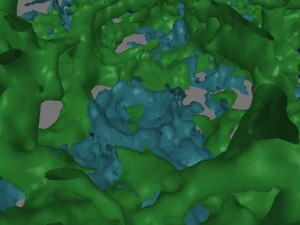Advanced Graphics and Interaction
The Effective Virtual Environments (EVE) subproject conducts basic research into what is required of hardware and software systems to make virtual environment-based applications effective. We apply the results of our basic research to applications for the stereo display of 3D microscopy data sets and to medical applications in Motion Science and Rehabilitation.
EVE for Microscopy is developing visualization and interaction tools for 3D microscopy data sets.
Simple Stereo Systems for 3D Microscopy is exploiting new, consumer-grade stereo hardware to develop, evaluate, and deploy moderate-cost systems for viewing 3D microscopy data sets. We are deploying and evaluating the usefulness of these systems first locally and then in collaborators’ labs.
Virtual Environments for Motion Science and Rehabilitation is a high-risk, high-payoff project and applies our VE technology to medical therapy. Recently, we did a pilot project with Prof. Kevin Guskiewicz, (Chair, Department of Exercise and Sports Science), investigating the application of virtual environment technology to rehabilitation for concussed athletes. CISMM led a study that established the basic feasibility of using head-worn displays with concussed athletes: the weight of the head-worn apparatus does not cause a pathological change in balance in healthy young adults (Mihalik 2007).
 Brain injuries can be caused by stroke, automobile accidents, military actions, and sports activities, among other hazards. The number of brain injuries is growing as the population ages and the United States continues military operations. This project supports a new collaboration that addresses both research and therapy for patients with brain injury. The collaboration is with the newly formed Human Motion Science Laboratory within the Medical School at UNC, where Rick Segal and Michael Lewek study balance and gait. The use of virtual environment (VE) technology will expand the range of stimuli that can be presented to patients safely and will enable a new, real-time visual feedback medium. Immediately, we are developing control and display systems for a dual-belt treadmill, instrumented with a four-sensor force plate under each belt. Such treadmills are used to study balance and locomotion in patients with stroke and brain injuries. Our hypothesis is that variations in ground-force reaction can be used to set both speed and direction of motion through a displayed virtual scene. Our physical therapy collaborators believe that providing real-time visual feedback of the consequences of incorrect gait will speed rehabilitation after stroke.
Brain injuries can be caused by stroke, automobile accidents, military actions, and sports activities, among other hazards. The number of brain injuries is growing as the population ages and the United States continues military operations. This project supports a new collaboration that addresses both research and therapy for patients with brain injury. The collaboration is with the newly formed Human Motion Science Laboratory within the Medical School at UNC, where Rick Segal and Michael Lewek study balance and gait. The use of virtual environment (VE) technology will expand the range of stimuli that can be presented to patients safely and will enable a new, real-time visual feedback medium. Immediately, we are developing control and display systems for a dual-belt treadmill, instrumented with a four-sensor force plate under each belt. Such treadmills are used to study balance and locomotion in patients with stroke and brain injuries. Our hypothesis is that variations in ground-force reaction can be used to set both speed and direction of motion through a displayed virtual scene. Our physical therapy collaborators believe that providing real-time visual feedback of the consequences of incorrect gait will speed rehabilitation after stroke.
